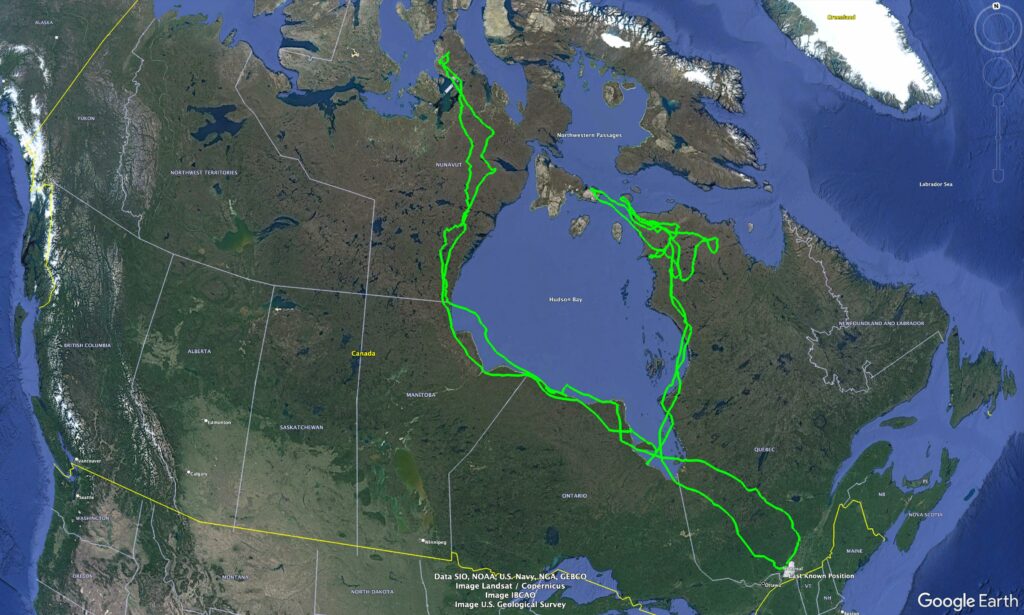
Hochelaga’s 2022-24 travels, up into the central Arctic in 2022 and the Ungava Peninsula and Southampton Island last summer. (©Project SNOWstorm and Google Earth)
It’s been a long time coming, is all I can say.
Last night (Sunday, Jan. 14) my cell phone started buzzing around 7 p.m. Eastern time, as my wife and I were eating dinner. I glanced to see who was texting me, and almost dropped my fork when I saw the words “CTT Check-in Alert: Unit Newton – ATY Male.” Newton, one of our 2023-tagged owls, had finally flown back south into cell range and was transmitting data.
I let out a whoop, but before I could even open the alert to see where Newton was, another one came buzzing through: “CTT Check-in Alert: Unit Hochelaga – A5Y Male.” This was even bigger news, because Hochelaga, an adult male trapped at the Montréal-Trudeau Airport by biologist Julie Lecours of Falcon Environmental on March 2, 2021, and tagged by Becca McCabe from SNOWstorm, hadn’t come south last winter. When he was caught in 2021 they found he was already banded, having been caught there as an adult in 2016 — making him at least nine or 10 years old this winter.
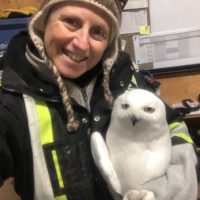
Julie Lecours with Hochelaga in 2021. (©Julie Lecours)
Hochelaga’s transmitter has been busy while he’s been away, and it downloaded more than 25,000 precise GPS positions stored up over the past nearly two years. Newton’s did the same for his movements over the past 10 months.
So where have they been? In spring 2022, Hochelaga migrated across James Bay, up the western side of Hudson Bay and summered on the Boothia Peninsula in the central Canadian Arctic, though his track never settled in one spot suggesting nesting behavior. He then spent the first part of the winter of 2022-23 on the edge of Hudson Bay, right on the Manitoba/Ontario border, later hopscotching south and east from February through May 2023 around James Bay before heading north again. After crossing briefly to Southampton Island, Hochelaga spent the rest of the summer on the Ungava Peninsula an in northern Québec.
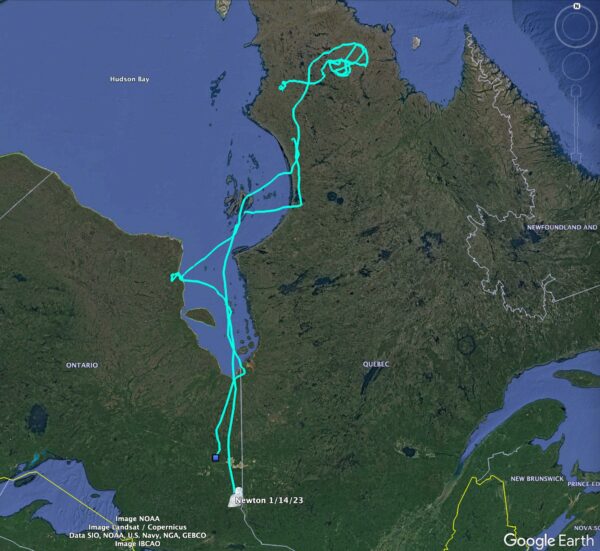
Newton’s track from March 2023 to Jan. 2024. (©Project SNOWstorm and Google Earth)
That’s also where Newton spent this past summer, and unlike Hochelaga, who never settled in one spot, the tracking data suggest that Newton may have been tending a nest there. (It’s a bit harder to tell with males, since they don’t spend days and weeks incubating, but he remained in a very small area all summer).
Interestingly, both owls remained far north in the Ungava until just the past couple of weeks, then moved rapidly south and back into cell range. Hochelaga moved almost 1,600 km (1,000 miles) in a little more than two weeks, following the edges of Hudson and James Bay and winding up Sunday night just north of Montréal, and only 30km (20 miles) from where he’d wintered in 2021-22.
Newton’s transmitter went dark on Dec. 24, likely from the lack of solar recharge that far north. When it kicked in again on Jan. 2, 2024, he’d moved 160 km (100 miles) south and kept on moving, arriving Jan. 14 near Timiskaming, ON, a flight of 1,300 km (800 miles).
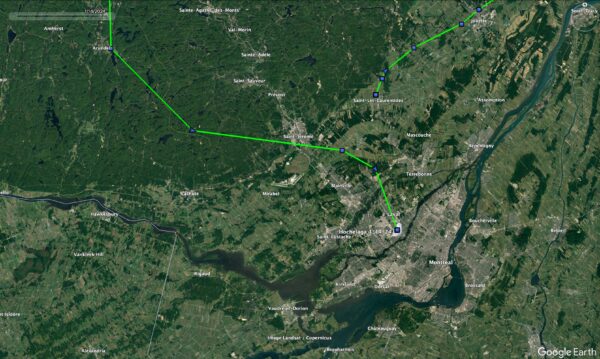
Right back where he started: Hochelaga wound up less than 30 km from where he’d wintered in 2021-22. (©Project SNOWstorm and Google Earth)
So, why the sudden reappearance? We suspect the belated arrival of serious cold and snow probably played a big role, although Hochelaga has now shown a tendency to remain far north late, even in years he eventually comes south. Ice cover data for Hudson Bay shows the last wee bit of open water and thin ice vanished around Jan. 10, just as they were heading south, which may have chased off any remaining waterbirds. More to the point, we’re hopeful this may shake more of our tagged veterans south into cell range, and bring other untagged owls down here as well.
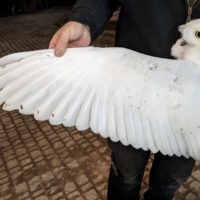
Newton, at least five years old, is an almost pure white male.
We’d love to deploy new transmitters on appropriate owls this winter, and the fact that we haven’t isn’t for lack of trying. For example, SNOWstorm team members Charlotte England and Malcolm Wilson (who tagged Newton last year) racked up nearly 3,000 km (1,860 miles) over 10 days banding winter raptors like rough-legged hawks in southern Ontario, but did not see a single snowy owl. They’ll be back out again early next month, and our fingers are crossed their luck will be better.
Meantime, Hochelaga and Newton’s map data will be updated with their recent travels, and will continue to update periodically this winter (though as always, it will be time-delayed by at least 24 hours, so no one can kind where they are at any given moment).


20 Comments on “Finally — Owls!”
Amazing news! Thank you for this educational update and all that this project does!
The gift of perseverance and hope, finally pays off! Snowy owls are on the horizon! Hurray!
Scott!
Your news literally brought tears to my eyes…This is wonderful Thank you so much for all you do for these special beautiful creatures. I drive around all year with your project snowstorm sticker on my car..People often ask me what it is all about..I tell them of your endeavors and ask them to look into your work and please donate to the cause.
Wonderful ! Very few spotted in ND yet but looking on ebird there are quite a few sitings just north of us in southern Canada.
Scott, thanks for the wonderful update on a (maybe not coincidental) beautiful snowy day!
Great news, especially in conjunction with your fantastic informative Zoom webinar with Birds and Beans last week.
There have been a few that moved in this month from eastern Ontario to western Quebec but don’t expect to see any numbers close to the recent past winters.
https://pbase.com/golfpic/some_recent_shots
Yes that’s great news !
Also one of the owls ( Hochelaga) from Dorval Airport is back, well somme people I know will be
happy to ear that.
Thanks for the update!
WOW! So exciting! Appreciate the update on these amazing and beautiful birds!
Thank you for ALL you do toward Snowy Owl conservation, science and education.
Best Regards,
Lori
Too cool! I had a snowy owl visit me in the way early morning hours on 12/22/23! I live in North East Texas in Wolfe City, and I did not know they even came here! I do know that it was a snowy owl. On account if how close it flew right over me and I mean right over me! Then landed and sat on our highest tree in the yard! I ran and got my phone to take pictures. It was eerily foggy that morning though so the photos are not the best quality. Still though you can see it in the the tree just sitting there in all its magnetic glory! It was an amazing experience for me !!!
That is good news on these two snowy owls.
We haven’t seen any in the Angus/Barrie area so far. Bad year.
Any possibility this is Hochelaga? Saint-Roch-Ouest
Montcalm Regional County Municipality, QC.
Oops. Sorry, I just saw the photo of the owl in question and it is a young heavily barred snowy owl. So, NOT Hochelaga.
Finally saw a Male Snowy Owl here today in NW North Dakota. The cold weather must have pushed them farther south. January 17th
Can I get a Data Hallelujah? So happy for you that two all stars finally checked in!
Hello m’y name is Monique Maynard we live in the province of Québec and we are looking but have not seen any yet .The name of our town is Châteauguay.
Monique. Check eBird. You have one at Dorval. One in St. Roch (young bird) and one in Ste Barthelemy. Another in TechnoParc but this one will be harder to find as exact location is not posted. The map of Hochelaga shows last location and it looks to be just north of St. Roch. It could still be on the move.
https://pbase.com/golfpic/some_recent_shots
That’s great news! I live in the Holland Marsh in Ontario and we have not see our female here yet. It’s late for them but attribute it to lack of snow and cold temps since December. Hopefully next week is the week!
Woohoo!!! That’s great news, thanks for the update Scott!! It’s interesting that they both started South pretty much at the same time. Here’s hoping we’ll see more snowies arrive in the next weeks.
Well, we finally have our first reported snowy owl, a heavily barred individual I saw at a well known location for seeing snowy owls every winter. This is in the Eagleson and Fallowfield area in Ottawa (Kanata or Stittsville depending on how the municipality lines are drawn). eBird in the USA used to have a daily snowy owl alert where they publish all snowy owl sightings, whether confirmed or not. This one was on Brownlee.